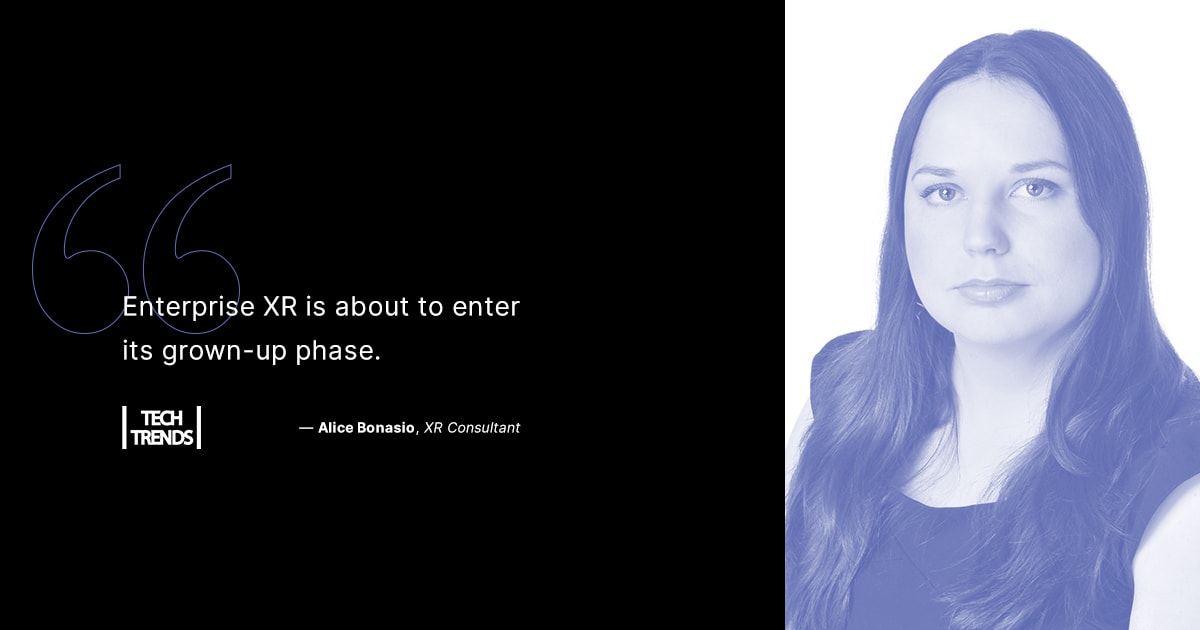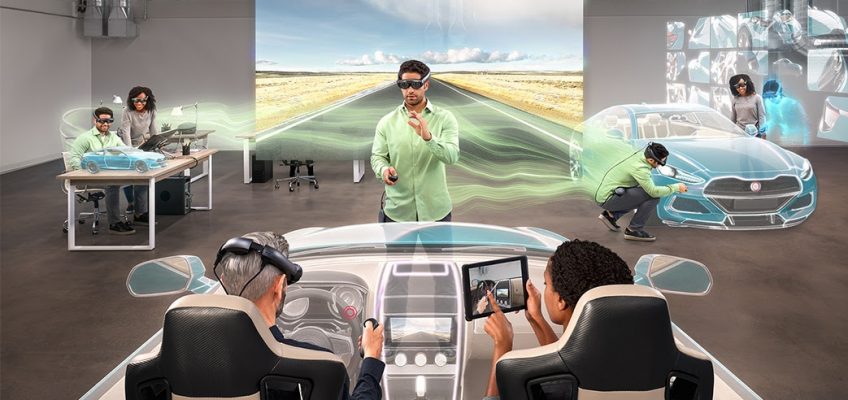Unity’s Latest Trends Report Declares 2020 will be a Breakthrough Year for XR. 15 Experts weigh in on why we’re reaching a tipping point in spatial computing.
This looks to be the year where we move beyond tentative experimentation into scalable deployment of immersive tech in the workplace. That’s the consensus that seems to emerge from “Top 2020 Trends: Enterprise AR & VR” a report published today by Unity Technologies, where 15 industry experts (yours truly among them) outlined how Mixed Reality (or XR depending on what flavor acronym you favor) will supercharge and transform the world of work.
XR has proven to be a paradigm shift for enterprise in terms of boosting productivity, cost-savings, and learning and development Share on XAccording to the report, we can expect even cautious companies to finally follow in the footsteps of their pioneering counterparts as XR becomes more accessible and mainstream, driven by a wave of new and improved HMDs, mobile AR and standalone VR, and the onset of 5G networks.
This looks to be the year where we move beyond tentative experimentation into scalable deployment of immersive tech in the workplace Share on XXR has proven to be a paradigm shift for enterprise in terms of boosting productivity, cost-savings, and learning and development, particularly in relation to highly skilled and specialized areas ranging from surgery to spacecraft engineering. Yet where so far we have seen pioneering companies work largely on an experimental trial-and-error basis, this next decade will see research catching up to meaningfully support this deployment on the ground.
We can expect even cautious companies to finally follow in the footsteps of their pioneering counterparts as XR becomes more accessible and mainstream Share on XInstead of a one-size-fits-all approach, enterprise stakeholders will increasingly have the information and expert guidance at their disposal to tailor and customize solutions optimized for their specific industry, goals, and needs.
A recent Harvard Business Review Analytic Services study found that 87% of large companies are currently exploring, piloting, or deploying Mixed Reality, but the vast majority of those are still in the exploratory or proof-of-concept stages.
Academic research is now being conducted all over the world to investigate not if XR works but how it works and what considerations must be taken into account when designing content. One recent example is this article published on Frontiers in Psychology, which identifies significant differences in how people retain information in the short and long term depending on whether content is delivered in “active” or “passive” VR modes.
In the last couple of years, major companies everywhere ran proof-of-concept XR projects with uniformly positive results Share on XAs more such studies are conducted, and more use cases are shared among enterprise stakeholders across an expanding ecosystem of different industries, we will move on from the heady days of experimental exploration and marveling at the power of immersive technologies towards more targeted, considered, evidence-based and industry-specific approaches. In other words, enterprise XR is about to enter its grown-up phase.
A Harvard Business Review Analytic Services study found that 87% of large companies are currently exploring, piloting, or deploying Mixed Reality Share on X
“After a few years of testing applications, many verticals and use cases have proven ROI. The perception of gimmickry has given way to real business value,” says Maria Fernandez Guajardo, Facebook’s Director of Enterprise AR/VR, adding that 2020 is going to be a critical, if not glamorous, time for enterprise VR. “The industry will need to put in the arduous work of scale: establishing infrastructure, integrating workflows and connecting a comprehensive ecosystem,” she says.
With its effectiveness well established, the time has come for XR to move beyond “fancy demos, proof-of-concepts and pilots” to become “an indispensable digital productivity tool” used across the entire product lifecycle, from R&D to marketing to maintenance the report reads.
Academic research is now being conducted all over the world to investigate not if XR works but how it works and what considerations must be taken into account when designing content Share on XYet these new opportunities also bring new challenges. Timoni West, Director of XR Research Unity Labs says UX designers will have to adjust in order to meet the demand for these new kinds of experiences. “Instead of making responsive design just for different devices, they’ll have to start thinking about responsive design as computers react to everything in the real world. Gestures, voice, gaze, time of day, how many people are in the room, and where you are: all of these variables are now new user inputs that have to be taken into account,” she explains.
According to Vinay Narayan VP, Platform Strategy and Developer Community HTC VIVE, this upcoming year will present the most robust ecosystem of innovations yet. “Technological innovations will make XR experiences a widely accessible tool for industrial enterprises of any scope and size,” he says.
There is also a lot of hard work to be done on the infrastructure and connectivity side for this promise to be delivered: “We can expect that enterprises will be spending less time on UX experiments and more time on designing a solid infrastructure around the data,” says Andreea Raducan, Head of Marketing at Innoactive, adding that whether we’re looking at 3D assets, VR apps, internal processes information, or lines of code, data needs to flow across platforms and reach various locations in real-time.
Enterprise XR is about to enter its grown-up phase Share on X“As 5G networks come online, graphics and compute will increasingly be served from the network edge,” adds NVIDIA’s Director of Virtual Reality David Weinstein. “In the last couple of years, major companies everywhere ran proof-of-concept XR projects. The results were uniformly positive: faster time to market, lower total costs, better trained employees, happier customers, healthier patients. These early results will drive a virtuous cycle of growth and innovation,” he concludes.
You can download the full report for free here
Want the latest insights from industry experts in enterprise AR & VR? Look no further!
Read our blog to see how 2020 will be a defining year 👇https://t.co/zyibVIsMR8
— Unity (@unity3d) February 12, 2020
Tech Trends offers a broad range of Digital Consultancy services to guide companies, individuals and brands in effectively leveraging existing and emerging technologies in their business strategy.
Alice Bonasio is a XR and Digital Transformation Consultant and Tech Trends’ Editor in Chief. She also regularly writes for Fast Company, Ars Technica, Quartz, Wired and others. Connect with her on LinkedIn and follow @alicebonasio on Twitter.









